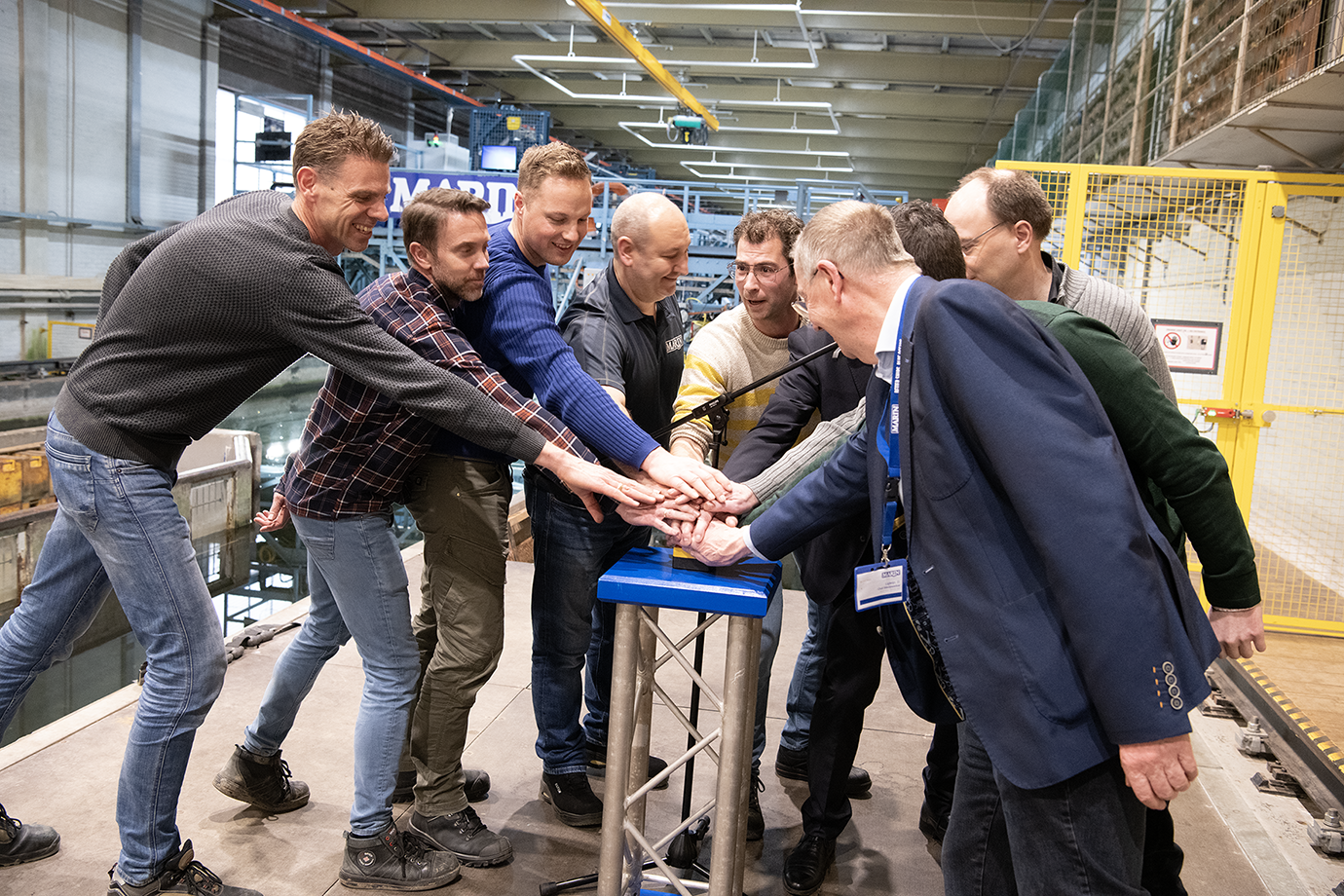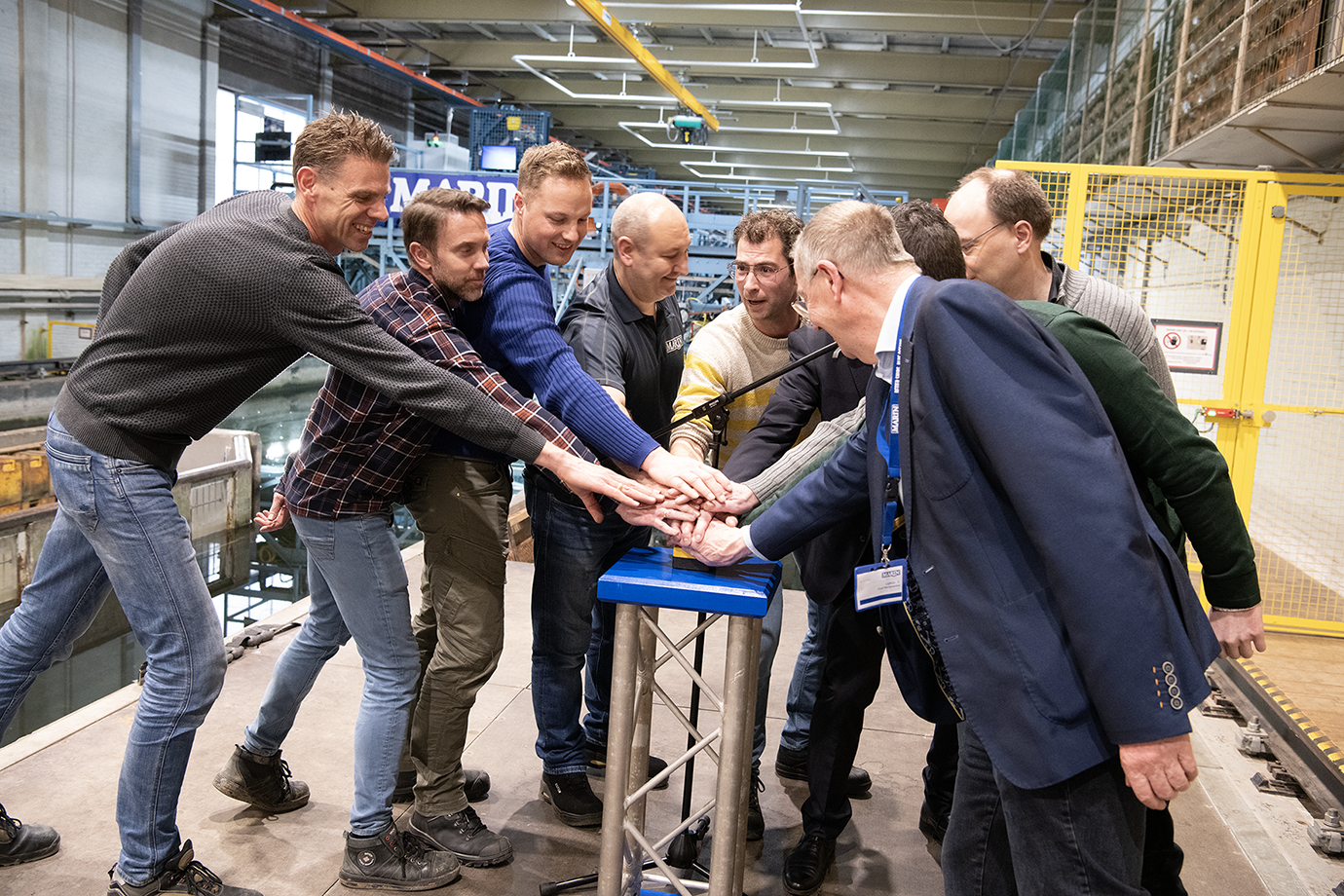June 2023, no. 136
News
BlueWeek
AI Sail
TopTier
CFD
Zero Emission
Foil Design
Traffic studies
F-series
Manxman ferry
Cover


Create a MARIN account to stay updated

Report
Famous B-series propellers replaced by the F-series
a major milestone
in maritime history
On February 15, MARIN’s near-centenarian Deep Water Towing Tank was abuzz with excitement and anticipation. Over half a century ago, the Wageningen B-series propellers were tested here.

It was the day of the final test of the last propeller model in the new series of 150 propellers, marking a major milestone in marine propeller design.
As the red button was pushed down by the F-series Project Team, the carriage sprang into action, faithfully executing its fully automated open-water measurement programme to collect the final set of performance data. We interview Jie Dang, Senior Project Manager Ships Powering, about this historic moment.
Since its establishment in the 1930s, MARIN - then known as the Netherlands Ship Model Basin (N.S.M.B.) - developed the well-known Wageningen B-series propellers. These were the first series of 4-bladed propellers, Jie explains. “They had small blade area ratios and wide blade tips with circular back sections on the outer radii and air foil-shaped sections on the inner radii, and they were designed for peak open-water efficiency.” Over a span of more than 40 years, the series expanded to include many more blade area ratios and blade numbers, making it the most comprehensive series of fixed-pitch propellers, he emphasises.
Industry standard
The B-series propellers encompassed a wide range of blade numbers (2 to 7), pitch ratios (0.5 to 1.4) and blade area ratios (0.3 to 1.05). “For decades, these propellers served as the industry standard for optimising the initial selection of marine propulsion systems. However, their geometry no longer represented contemporary propeller designs as they did not consider crucial factors such as cavitation, vibration and noise performance.”

Below: Propeller designs are for mainstream seagoing merchant and passenger ships. Propeller models ranging from 25 cm to 34 cm in diameter. Models were spun at speeds exceeding 2000 RPM. Four-quadrant data were obtained with just eight test runs per propeller.
Most efficient propellers
The project commenced with an inventory of detailed propeller designs for mainstream seagoing merchant and passenger ships: containers and bulkers, oil tankers and car carriers, cruisers and ferries, etc. This ensured that each propeller in the new series represented a practical and realistic design for real ships, Jie stresses. The multi-objective optimisation tool, PropArt, coupled with the Boundary Element Method (BEM) – PROCAL, pushed each design to its optimum while adhering to the class notations on strength, hull vibration and cabin noise levels. The best propellers in terms of efficiency, cavitation-erosion risk, hull-pressure fluctuation levels and strength of the tip-vortex cavitation were selected and incorporated into the entire series.
To minimise scale effects, large propeller models were manufactured ranging from 25 cm to 34 cm in diameter. These models were spun at speeds exceeding 2000 RPM, aiming to achieve the highest possible Reynolds numbers for each propeller without triggering cavitation. By employing the quasi-steady test technique, four-quadrant open water characteristics of all propellers were obtained with just eight test runs per propeller, Jie adds.
User-friendly software tool
After sampling, filtering and reduction, the test data were fitted both with Fourier series for the four-quadrant and with polynomials to cover the first quadrant from bollard pull, through normal propulsion, towards energy regeneration to meet the demands of the ongoing energy transition and electrification efforts. Regression analysis was conducted to generate smooth series polynomials, enabling interpolation over the blade area ratio and pitch ratio. Furthermore, the new propeller series also includes polynomials for determining the mass and moment of inertia of the propeller material, as well as for the entrained water. All data has been incorporated into a user-friendly software tool called MFC, providing both a graphic interface for easy utilisation and a computation core for software developers to integrate into their own systems. A Rhino F-series plug-in was delivered to create high-quality surface representations of the propeller geometry for CFD analysis
Jie emphasises: “The JIP certainly achieved its objectives and came to a successful conclusion.” Marking the completion of the project, a closing meeting took place during the VOF at MAN Energy Solutions on June 8, 2023, in Frederikshavn, Denmark.
More info:

The Wageningen F-series

Design of the Wageningen F-series







June 2023, no. 136
Report
Design of the Wageningen F-series


The Wageningen F-series

More info:
To minimise scale effects, large propeller models were manufactured ranging from 25 cm to 34 cm in diameter. These models were spun at speeds exceeding 2000 RPM, aiming to achieve the highest possible Reynolds numbers for each propeller without triggering cavitation. By employing the quasi-steady test technique, four-quadrant open water characteristics of all propellers were obtained with just eight test runs per propeller, Jie adds.
User-friendly software tool
After sampling, filtering and reduction, the test data were fitted both with Fourier series for the four-quadrant and with polynomials to cover the first quadrant from bollard pull, through normal propulsion, towards energy regeneration to meet the demands of the ongoing energy transition and electrification efforts. Regression analysis was conducted to generate smooth series polynomials, enabling interpolation over the blade area ratio and pitch ratio. Furthermore, the new propeller series also includes polynomials for determining the mass and moment of inertia of the propeller material, as well as for the entrained water. All data has been incorporated into a user-friendly software tool called MFC, providing both a graphic interface for easy utilisation and a computation core for software developers to integrate into their own systems. A Rhino F-series plug-in was delivered to create high-quality surface representations of the propeller geometry for CFD analysis
Jie emphasises: “The JIP certainly achieved its objectives and came to a successful conclusion.” Marking the completion of the project, a closing meeting took place during the VOF at MAN Energy Solutions on June 8, 2023, in Frederikshavn, Denmark.

Most efficient propellers
The project commenced with an inventory of detailed propeller designs for mainstream seagoing merchant and passenger ships: containers and bulkers, oil tankers and car carriers, cruisers and ferries, etc. This ensured that each propeller in the new series represented a practical and realistic design for real ships, Jie stresses. The multi-objective optimisation tool, PropArt, coupled with the Boundary Element Method (BEM) – PROCAL, pushed each design to its optimum while adhering to the class notations on strength, hull vibration and cabin noise levels. The best propellers in terms of efficiency, cavitation-erosion risk, hull-pressure fluctuation levels and strength of the tip-vortex cavitation were selected and incorporated into the entire series.
Propeller designs are for mainstream seagoing merchant and passenger ships. Propeller models ranging from
25 cm to 34 cm in diameter. Models were spun at speeds exceeding 2000 RPM. Four-quadrant data were obtained with just eight test runs per propeller.

Since its establishment in the 1930s, MARIN - then known as the Netherlands Ship Model Basin (N.S.M.B.) - developed the well-known Wageningen B-series propellers. These were the first series of 4-bladed propellers, Jie explains. “They had small blade area ratios and wide blade tips with circular back sections on the outer radii and air foil-shaped sections on the inner radii, and they were designed for peak open-water efficiency.” Over a span of more than 40 years, the series expanded to include many more blade area ratios and blade numbers, making it the most comprehensive series of fixed-pitch propellers, he emphasises.
Industry standard
The B-series propellers encompassed a wide range of blade numbers (2 to 7), pitch ratios (0.5 to 1.4) and blade area ratios (0.3 to 1.05). “For decades, these propellers served as the industry standard for optimising the initial selection of marine propulsion systems. However, their geometry no longer represented contemporary propeller designs as they did not consider crucial factors such as cavitation, vibration and noise performance.”
It was the day of the final test of the last propeller model in the new series of 150 propellers, marking a major milestone in marine propeller design.
As the red button was pushed down by the F-series Project Team, the carriage sprang into action, faithfully executing its fully automated open-water measurement programme to collect the final set of performance data. We interview Jie Dang, Senior Project Manager Ships Powering, about this historic moment.
On February 15, MARIN’s near-centenarian Deep Water Towing Tank was abuzz with excitement and anticipation. Over half a century ago, the Wageningen B-series propellers were tested here.
a major milestone
in maritime history
Famous B-series propellers replaced by the F-series












